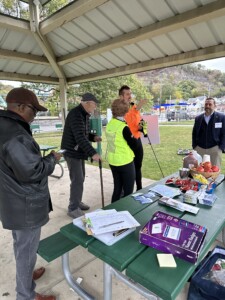PROJECT OVERVIEW

In fall 2022, Friends of the Riverfront secured funding for a feasibility study and the preliminary engineering for the extension of the Three Rivers Heritage Trail from the Hazelwood Green development to the Carrie Furnace redevelopment site.
The feasibility study component of the project will evaluate the potential for on and off-road trail alignments on either side of the existing Duck Hollow Trail: downriver to Hazelwood Green and upriver to the Carrie Furnace redevelopment site. Once an alignment is finalized, the consultant will begin developing preliminary engineering documents for the proposed trail alignment.
Thorough community engagement is needed to determine the preferred trail alignment and a high level of coordination with other agencies to address accessibility, railroad crossings, etc. This trail will be used by the local community as a recreational asset and a transit facility, we well as being used by regional visitors.
The project will run from May 2023 through December 2024.
COMMON QUESTIONS
Click here to read through our FAQ document. If you have additional questions, ask them here!
Preferred Route
Based on the responses and feedback received through two (2) public comment surveys, community events and the November Public Meeting, a preferred route has been selected. The route begins at the intersection of Tecumseh Street and Blair Street, where it will connect into the bicycle infrastructure along Blair Street within Hazelwood Green in the future. From this intersection, the route continues along Blair Street as on-street infrastructure (detailed design in progress) to Blair Street Park.
From Blair Street Park, the route goes toward the existing Melanchton Street pedestrian bridge, but the final design proposes to build a new, ADA-accessible bridge (similar to the Hot Metal Bridge or the Whitaker flyover across the railroad tracks to Dyke Street. The route continues past the City’s DPW lot to Dyke Street, then uses Herbert Way to Sickle Street (the on-road design of these portions is in progress).
From the end of Sickle Street, the trail will continue below the Glenwood Bridge to a second flyover bridge (similar to Whitaker flyover) to cross the railroad tracks and connect users to the existing Duck Hollow trail. From the Duck Hollow Trail to Carrie Furnace, the project team is working with the County, CSX and other stakeholders to determine the exact alignment of the connection to the Carrie Furnace site. Stay tuned for more information as the project progresses!

PROJECT TIMELINE
The Engineering Team (led by Traffic, Planning & Design) and Friends of the Riverfront have been working on:
May 2023: Project kick-off, review of existing community plans and initiatives
June-August 2023: Beginning the process of right-of-way and utility review related to the potential corridor and CSX property (as related to crossing the rail lines to access Duck Hollow from Hazelwood), reviewing historic records related to right of way, etc.
September – October 2023: Preparing for upcoming public outreach and community engagement
November 2023: Public Meeting with Hazelwood Initiative (Nov 14)
December 2023: Wrapping up public input on trail route via online survey regarding the potential routes from Hazelwood to Duck Hollow.
January – February 2024: A preferred route has been selected, conversations are progressing with City, CSX and other stakeholders. Preliminary design and engineering is ongoing.
CURRENT OUTREACH
Thank you to everyone who provided input on our second survey about the potential routes from Hazelwood to Duck Hollow! Our team is busy analyzing the results to determine which route will move into preliminary design and engineering.
An upcoming Public Presentation is slated for Summer 2024.
PROJECT FUNDING
Funding for this project was provided by the Redevelopment Authority of Allegheny County (RAAC)’s Trail Development Fund, which was made possible via the passage of the American Rescue Plan Act (ARPA) in 2021.




















